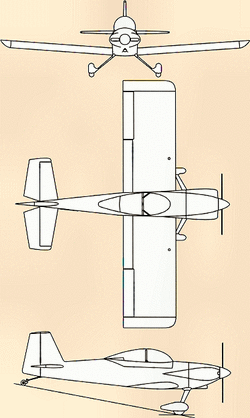Fri, Oct 13, 2023
A Mystery Half-Solved

The NTSB has released its final report on a 31 October 2021 accident in which a Vans RV4 (file photo), registration N479JJ, was destroyed and its 79-year-old Private Pilot suffered fatal injuries during a cross-country flight from Florida’s Tallahassee International Airport (TLH) to Alabama’s Monroe County Airport (MVC).
The accident-aircraft was operated as a private flight under Part 91 of the Federal Aviation Regulations.
The NTSB set forth:
“The pilot departed the airport for a cross country flight. Shortly after departure, radar services were terminated by air traffic control and the pilot was cleared for a radio frequency change. Seventeen minutes later, radar contact was lost. Automatic dependent surveillance-broadcast data obtained from the Federal Aviation Administration revealed the airplane climbed to about 2,500 ft mean sea level and made a few turns to the north and northeast before heading northwest. The airplane began to lose groundspeed, turned to the left and descended, then gained groundspeed as it continued to descend. The last data track showed the airplane at 650 ft and a groundspeed of 172 knots.
“A witness was outside at his house when the canopy from the airplane fell in his yard. The canopy was about 1.5 miles away from the main wreckage. The accident site was in a wooded area and the wreckage path was about 550 ft long. The airplane was heavily fragmented and scattered along a debris path. The canopy handle was found in the open position with the looking pin damaged and bent at its tip. It is likely that the canopy was not locked correctly before takeoff and that it opened in flight and departed the airplane.

The airplane then made a gradual slow left descending turn and continued to gain airspeed until it contacted trees and the ground at a high rate of speed. Based on the available evidence, it could not be determined if the canopy contacted and incapacitated the pilot when it separated from the airplane, which then resulted in a loss of control.”
The NTSB determined the mishap was likely caused by the pilot’s failure to properly secure the accident-aircraft’s canopy prior to takeoff—an oversight that allowed subject canopy to open in flight and separate from the RV4. While the Board concluded the canopy’s separation from the aircraft precipitated the pilot’s failure to maintain control of the airplane, investigators were unable to determine why, precisely, the aviator was rendered unable to bring the aircraft safely to ground.
Parties interested in learning more about the described occurrence should reference NTSB Accident Number ERA22FA036.
More News
Cooperative Surveillance Any surveillance system, such as secondary surveillance radar (SSR), wide-area multilateration (WAM), or ADS-B, that is dependent upon the presence of cert>[...]
Aero Linx: OX5 Aviation Pioneers Incorporated in 1955 as a Pa 501 (c)(3) Not for Profit Corporation, the OX5 Aviation Pioneers is dedicated to bringing before the public the accomp>[...]
The Pilot Appeared To Regain Control After Six Rotations And Attempted To “Fly Out” Inverted But Had Insufficient Altitude On November 8, 2025, at 1038 eastern standard>[...]
From 2018 (YouTube Edition): Aero-News Talks With The Airplane's Builder One of the many unique airplanes at AirVenture 2018 was a 1/3-scale B-17 bomber built by Jack Bally, who ta>[...]
Aero Linx: Society of U.S. Army Flight Surgeons (SoUSAFS) The Society of US Army Flight Surgeons (SoUSAFS) serves to advance the science and art of Aerospace Medicine and its allie>[...]
 ANN's Daily Aero-Term (12.04.25): Cooperative Surveillance
ANN's Daily Aero-Term (12.04.25): Cooperative Surveillance ANN's Daily Aero-Linx (12.04.25)
ANN's Daily Aero-Linx (12.04.25) NTSB Prelim: Extra Flugzeugproduktions EA 300/SC
NTSB Prelim: Extra Flugzeugproduktions EA 300/SC Classic Aero-TV: The Bally Bomber - The All Time Ultimate Warbird Replica?
Classic Aero-TV: The Bally Bomber - The All Time Ultimate Warbird Replica? ANN's Daily Aero-Linx (12.05.25)
ANN's Daily Aero-Linx (12.05.25)




